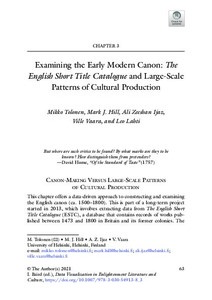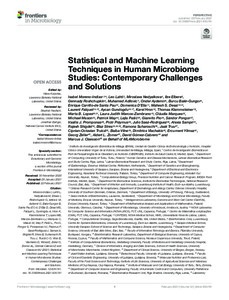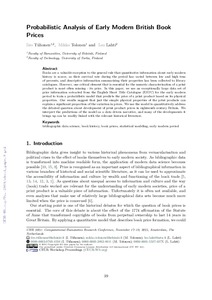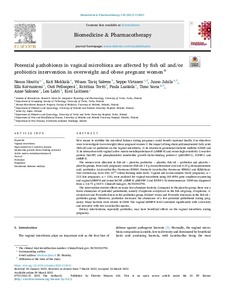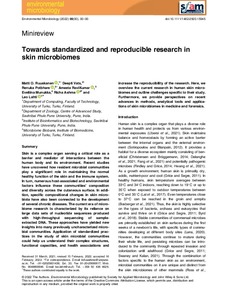Hae
Aineistot 11-18 / 18
Examining the Early Modern Canon: The English Short Title Catalogue and Large-Scale Patterns of Cultural Production
<p><br></p><p>This chapter presents the findings of an ongoing digital project of the Helsinki Computational History Group at Helsinki Centre for Digital Humanities (HELDIG) focused on the history of eighteenth-century book publication. The authors have created a historical-biographical database based on The English Short-Title Catalogue (ESTC), a standard source for analytical bibliographic research, and extracted a data-driven canon which considers changes over time, subject-topics, top-works, authors, publishers, publication place, and materiality. This chapter provides both methodological and historical insights into the development of print and demonstrates the huge analytical potential of harmonized metadata catalogs. While quantitative analyses of the book trade were attempted before, they did not engage with the complex process of canon formation at such a large scale. The authors’ work highlights the formative role played by publishers in this process and the epistemological shift started at the end of the seventeenth century, when religious works were increasingly replaced by literary works. As the authors argue, this shift in the production and consumption of print allowed for a reinvention of the canon during the eighteenth century.<br></p>...
Statistical and Machine Learning Techniques in Human Microbiome Studies: Contemporary Challenges and Solutions
The human microbiome has emerged as a central research topic in human biology and biomedicine. Current microbiome studies generate high-throughput omics data across different body sites, populations, and life stages. Many ...
Gut microbiota of patients with different subtypes of gastric cancer and gastrointestinal stromal tumors
Background Gastric adenocarcinoma is associated with H. pylori infection and inflammation that can result in the dysbiosis of gastric microbiota. The association of intestinal microbiota with gastric adenocarcinoma subtypes ...
Corpus Linguistics and Eighteenth Century Collections Online (ECCO)
<p>Eighteenth Century Collections Online (ECCO) is the most comprehensive dataset available in machine-readable form for eighteenth-century printed texts. It plays a crucial role in studies of eighteenth-century language ...
Probabilistic analysis of early modern British book prices
<p>Books are a valuable exception to the general rule that quantitative information about early modern history is scarce, as their survival rate during the period has varied between low and high tens of percents, and ...
Potential pathobionts in vaginal microbiota are affected by fish oil and/or probiotics intervention in overweight and obese pregnant women
<div><p>New means to stabilize the microbial balance during pregnancy could benefit maternal health. Our objectives were to investigate in overweight/obese pregnant women 1) the impact of long-chain <a href="https://www.sciencedirect.com/topics/medicine-and-dentistry/polyunsaturated-fatty-acid" title="Learn more about polyunsaturated fatty acids from ScienceDirect's AI-generated Topic Pages">polyunsaturated fatty acids</a> (fish oil) and/or <a href="https://www.sciencedirect.com/topics/medicine-and-dentistry/probiotic-agent" title="Learn more about probiotics from ScienceDirect's AI-generated Topic Pages">probiotics</a> on the <a href="https://www.sciencedirect.com/topics/pharmacology-toxicology-and-pharmaceutical-science/vagina-flora" title="Learn more about vaginal microbiota from ScienceDirect's AI-generated Topic Pages">vaginal microbiota</a>, 2) its relation to <a href="https://www.sciencedirect.com/topics/medicine-and-dentistry/gestational-diabetes" title="Learn more about gestational diabetes mellitus from ScienceDirect's AI-generated Topic Pages">gestational diabetes mellitus</a> (GDM) and 3) its interaction with vaginal active matrix metalloproteinase-8 (aMMP-8) and serum high sensitivity C-reactive protein (hsCRP) and phosphorylated insulin-like growth factor-binding protein-1 (phIGFBP-1), IGFBP-1 and aMMP-8.<br></p><p>The women were allocated to fish oil + placebo, probiotics + placebo, fish oil + probiotics and placebo + placebo-groups, from <a href="https://www.sciencedirect.com/topics/medicine-and-dentistry/first-trimester-pregnancy" title="Learn more about early pregnancy from ScienceDirect's AI-generated Topic Pages">early pregnancy</a> onwards (fish oil: 1.9 g <a href="https://www.sciencedirect.com/topics/medicine-and-dentistry/docosahexaenoic-acid" title="Learn more about docosahexaenoic acid from ScienceDirect's AI-generated Topic Pages">docosahexaenoic acid</a> and 0.22 g <a href="https://www.sciencedirect.com/topics/medicine-and-dentistry/icosapentaenoic-acid" title="Learn more about eicosapentaenoic acid from ScienceDirect's AI-generated Topic Pages">eicosapentaenoic acid</a>; probiotics: Lacticaseibacillus rhamnosus HN001 (formerly <a href="https://www.sciencedirect.com/topics/medicine-and-dentistry/lactobacillus" title="Learn more about Lactobacillus from ScienceDirect's AI-generated Topic Pages">Lactobacillus</a> rhamnosus HN001) and <a href="https://www.sciencedirect.com/topics/medicine-and-dentistry/bifidobacterium-animalis" title="Learn more about Bifidobacterium animalis from ScienceDirect's AI-generated Topic Pages">Bifidobacterium animalis</a> ssp. lactis 420, 10<sup>10</sup> colony-forming units each). Vaginal and serum samples (early pregnancy, n = 112; <a href="https://www.sciencedirect.com/topics/medicine-and-dentistry/third-trimester-pregnancy" title="Learn more about late pregnancy from ScienceDirect's AI-generated Topic Pages">late pregnancy</a>, n = 116), were analyzed for vaginal microbiota using <a href="https://www.sciencedirect.com/topics/medicine-and-dentistry/rna-16s" title="Learn more about 16S rRNA from ScienceDirect's AI-generated Topic Pages">16S rRNA</a> gene <a href="https://www.sciencedirect.com/topics/medicine-and-dentistry/amplicon" title="Learn more about amplicon from ScienceDirect's AI-generated Topic Pages">amplicon</a> sequencing and vaginal aMMP-8 and serum hsCRP, aMMP-8, phIGFBP-1 and IGFBP-1 by <a href="https://www.sciencedirect.com/topics/medicine-and-dentistry/immunoassay" title="Learn more about immunoassays from ScienceDirect's AI-generated Topic Pages">immunoassays</a>. GDM was diagnosed from a 2-h 75 g <a href="https://www.sciencedirect.com/topics/medicine-and-dentistry/oral-glucose-tolerance-test" title="Learn more about OGTT from ScienceDirect's AI-generated Topic Pages">OGTT</a>. ClinicalTrials.gov, NCT01922791.</p><p>The intervention exerted effects on many low-abundant bacteria. Compared to the placebo-group, there was a lower abundance of potential pathobionts, namely <a href="https://www.sciencedirect.com/topics/medicine-and-dentistry/ureaplasma" title="Learn more about Ureaplasma from ScienceDirect's AI-generated Topic Pages">Ureaplasma</a> urealyticum in the fish oil-group, Ureaplasma, U. urealyticum and <a href="https://www.sciencedirect.com/topics/medicine-and-dentistry/prevotella" title="Learn more about Prevotella from ScienceDirect's AI-generated Topic Pages">Prevotella</a> disiens in the probiotics-group, <a href="https://www.sciencedirect.com/topics/medicine-and-dentistry/dialister" title="Learn more about Dialister from ScienceDirect's AI-generated Topic Pages">Dialister</a> invisus and Prevotella timonensis in the fish oil + probiotics-group. Moreover, probiotics decreased the abundance of a few potential pathobionts during pregnancy. Many bacteria were related to GDM. The vaginal aMMP-8 level correlated significantly with α-diversity and inversely with two Lactobacillus species.</p><p>Dietary interventions, especially probiotics, may have beneficial effects on the vaginal microbiota during pregnancy.</p></div>...
Skin microbiota diversity among genetically unrelated individuals of Indian origin
<p><br></p><p>Background<br></p><p>Human skin harbors complex transient and resident microbial communities that show intra- & inter-individual variation due to various environmental and host-associated factors such as skin ...
Towards standardized and reproducible research in skin microbiomes
Skin is a complex organ serving a critical role as a barrier and mediator of interactions between the human body and its environment. Recent studies have uncovered how resident microbial communities play a significant role ...
